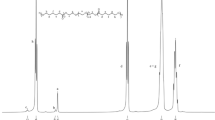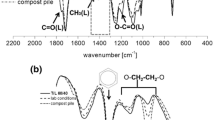Abstract
Two types of copolymers — poly(ester-amide)s — by the anionic copolymerization of ɛ-caprolactam and ɛ-caprolactone, and aromatic-aliphatic copolyesters based on glycolyzed polyethylene terephthalate from used beverage bottles and ɛ-caprolactone were prepared. Biodegradation tests of these copolymers were performed by two methods,viz. composting under controlled conditions and treatment with ligninolytic fungi. Both methods resulted in degradation of the copolymers, composting being more robust. Out of fungal strains testedInonotus hispidus degraded aromatic-aliphatic copolyesters most intensively.
Similar content being viewed by others
Abbreviations
- CLA:
-
ε-caprolactam
- CLO:
-
ε-caprolactone
- ETP:
-
ethylene terephthalate
- GPC:
-
gel permeation chromatography
- PETP:
-
poly(ethylene-terephthalate)
- SEM:
-
scanning electron microscopy
References
Amass W., Amass A., Tighe B.: A review of biodegradable polymers: uses, current developments in the synthesis and characterization of biodegradable polyesters, blends of biodegradable polymers and recent advances in biodegradation studies.Polym.Internat. 47, 89–144 (1998).
Averous L.: Biodegradable multiphase systems based on plasticized starch: a review.J.Macromol.Sci. C Polym.Rev. C44, 231–274 (2004).
Cajthaml T., Bhatt M., Šašek V., Matějů V.: Bioremediation of PAH-contaminated soil by composting: a case study.Folia Microbiol. 47, 696–700 (2002).
Chandra R., Rustgi R.: Biodegradable polymers.Progr.Polym.Sci. 23, 1273–1335 (1998).
Chromcová D., Bernáškova A., Brožek J., Prokopová I., Roda J., Nahlik J., šašek V.: Degradation of polyesteramides prepared by the anionic polymerization of ε-caprolactam in the presence of poly(ε-caprolactone).Polym.Degrad.Stab. 90, 546–554 (2005).
Deguchi T., Kakezawa M., Nishida T.: Nylon biodegradation by lignin-degrading fungi.Appl.Environ.Microbiol. 63, 329–331 (1997).
Deguchi T., Kitaoka Y., Kakezawa M., Nishida T.: Purification and characterization of a nylon-degrading enzyme.Appl.Environ.Microbiol. 64, 1366–1371 (1998).
Jang J.-C., Shin P.-K., Yoon J.-S., Lee I.-M., Lee H.-S., Kim M.-N.: Glucose effect en biodegradation of plastics by compost from food garbage.Polym.Degrad.Stab. 76, 155–159 (2002).
Kirk T.K., Farrell R.L.: Enzymatic combustion: the microbial degradation of lignin.Ann.Rev.Microbiol. 41, 465–505 (1987).
Klun U., Friedrich J., Kržan A.: Polyamide-6 fibre degradation by a ligninolytic fungus.Polym.Degrad.Stab. 79, 99–104 (2003).
Novotny Č., Rawal B., Bhatt M., Patel M., Šašek V., Molitoris H.P.: Capacity ofIrpex lacteus andPleurotus ostreatus for decolorization of chemically different dyes.J.Biotechnol. 89, 113–122 (2001).
Ohtaki A., Sato N., Nakasaki K.: Biodegradation of poly-ε-caprolactone under controlled composting conditions.Polym.Degrad.Stab. 61, 491–505 (1998).
Šašek V.: Why mycoremediation have not yet come into practice, pp. 247–266 in V. Šašek, J.A. Glaser, P. Baveye (Eds):The Utilization of Bioremediation to Reduce Soil Contamination: Problems and Solutions. Kluwer Academic Publishers, Dordrecht-Boston-London 2003.
Šašek V., Bhatt M., Cajthaml T., Malachová K., Lednická D.: Compost-mediated removal of polycyclic aromatic hydrocarbons from contaminated soil.Arch.Environ.Contamin.Toxicol. 44, 336–342 (2003).
Tien M., Kirk T.K.: Lignin peroxidase ofPhanerochaete chrysosporium.Meth.Enzymol. 161, 238–249 (1988).
Author information
Authors and Affiliations
Corresponding author
Additional information
The work was supported byGrant Agency of the Czech Republic (grant no. 203/03/0508) and also by research program of theMinistry of Education, Youth and Sports of the Czech Republic (MŠM 604 613 7302) andInstitutional Research Project of theInstitute of Microbiology (AV 0Z 5020 0510).
Rights and permissions
About this article
Cite this article
Šašek, V., Vitásek, J., Chromcová, D. et al. Biodegradation of synthetic polymers by composting and fungal treatment. Folia Microbiol 51, 425–430 (2006). https://doi.org/10.1007/BF02931586
Received:
Issue Date:
DOI: https://doi.org/10.1007/BF02931586




